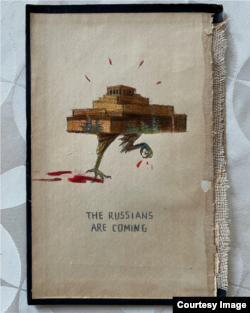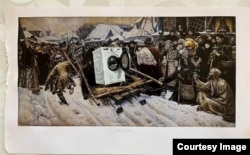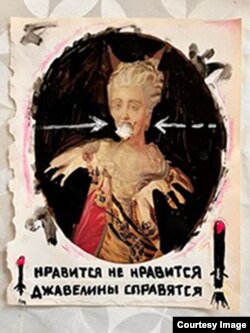ODESA, Ukraine -- Before the Russian invasion, Odesa-born artist Ihor Husev achieved considerable success at home and abroad with his haunting, dreamlike paintings: A ballet dancer stands on train tracks on the snow; a speedboat sits on a trailer by a lake, under a menacing sky that suggests summer is only a memory.
“It takes a month to make each of them,” he said, gesturing with his hand at a pile of oil-on-canvas paintings he made before February 24. “But it’s all irrelevant now -- we are living in a transformative moment.”
That moment started when Ukrainians in Odesa and elsewhere woke up that morning to a “nightmare,” he said, as Russian rockets fell in and near cities across the country.
Like millions of people in Ukraine and elsewhere, it was a nightmare he had not expected to become reality despite the tens of thousands of troops massing at the borders, threatening words from Russian President Vladimir Putin, and U.S. authorities warning that a full-scale invasion could come any day.
“Putin was announcing everything so ostentatiously and endlessly that I thought it was just another one of his scary fairy tales,” Husev recalled.
The invasion led to a new turn in Husev’s art, and a fairy tale figured in a drawing he published on Facebook on the first day of the invasion -- the first work in what he calls “series 3 world war 2022.”
Husev drew Lenin’s tomb walking on chicken legs dripping blood and wrote “the Russians are coming” beneath the image, whose meaning would be lost on almost nobody in Ukraine or Russia: The mummified past is approaching and it’s as scary as Baba Yaga, a wicked witch and the ultimate villain of Slavic folklore.
Husev was frightened, too. “But what could I do?” he asked. “My wife and I realized that we would rather die in our bed than run away, and I decided to keep people's spirits up by doing what I do best -- drawing.”
And he’s doing it with a sizable splash of Odesa’s best-known commodity: humor.
“If you can laugh at something, you stop being afraid, and when you stop being afraid, you are already a winner,” said Husev, 46.
As the death and destruction wreaked upon Ukraine continues with no end in sight and wariness is widespread in Odesa, which has been bombarded but has escaped capture, it’s humor with a dark streak.
There is Lenin’s tomb, uprooted from Moscow’s Red Square and leaving bloody tracks as it strides forth on chicken legs like Baba Yaga’s hut.
There is a drawing of farm fields and a road that eerily evokes misleadingly optimistic Soviet-era art and is captioned with a play on words, saying both “Everything will be fine” and “Everything will be fertilizer.”
And there is a drawing that echoes a famous 19th-century painting by the Russian artist Vasily Surikov, only here a sledge being pulled through the snow carries not a black-clad noblewoman under arrest but a shiny-white washing machine -- a reference to looting by Russian soldiers who have sent such goods back home from Ukraine.
In May, he published a simple piece that shows the Ukrainian and Russian spellings of his city’s name -- Odesa and Odessa -- with a fiery bang in place of each letter ‘s.’
Husev has garnered attention with his new works, finding himself invited to appear on TV news in his country, where the invasion has increased solidarity that had already been on the rise since 2014, when Russia seized the Crimean Peninsula -- southeast of Odesa -- and fomented war in the eastern region known as the Donbas.
What strikes almost anybody coming to the largely Russian-speaking port city in the fourth month since the invasion is the proliferation of blue-and-yellow national flags that are painted on the walls of a great many buildings.
“The janitors who painted them are the true artists of today,” Husev said, talking as he walked around his sunlit studio filled with books, plants, and sculptures. “Unlike some of my artist friends, who keep on painting flowers and landscapes.”
Husev’s wartime drawings, meanwhile, are all made on the pages and covers of old books he bought at Starokonka, an Odesa flea market. Remakes of pictures from the Soviet schoolbook Mother Tongue are among his favorites.
He believes the artworks he publishes on social media are popular precisely because this aesthetic of torn books, deconstructed classics, and ridiculed Soviet heroes resonates with today's audience.
Some of his works have been printed out and displayed at Odesa’s central Book Market, which has become a popular meeting spot -- a venue for jazz concerts and theater performances -- as the city seeks to come back to life after the initial shock caused by the war, despite continued attacks.
“We are all living in a state of altered consciousness. There was a psychedelic revolution in art back in the day, and today there’s the bombardirovka,” he said -- Russian for bombardment.
To people enjoying their morning coffee at the Book Market, Odesa seems calm. Military experts argue that as long as Ukraine’s defensive line is maintained in Mykolayiv, more than 100 kilometers to the northeast, the city is safe.
With thousands of internally displaced people flowing in and out, a daily curfew, and beaches mined against the threat of an amphibious attack, anti-Russian sentiment appears to be growing in Odesa.
In mid-April, five plaques of Russian sister cities were taken down on a central square, and the mayor vowed to replace them with names of cities that have offered help during the current war.
Husev, who describes himself as a Russian-speaking Ukrainian patriot, argues that the storied city’s past and identity need to be rethought with caution.
“I wouldn’t just dismantle the statue of Catherine the Great, who founded Odesa,” he said, referring to a contentious monument in the city center. “It’s a great piece of architecture, unlike the dumb copies of Lenin that we have rightly gotten rid of.”
“I would rather put a blue and yellow scarf on her neck,” he added.
Husev said he believes that while Russia is wreaking thoughtless destruction upon Ukraine, Odesa will be able to break with its Russian legacy in a self-reflective manner because at its heart it has always been a cosmopolitan and European city.
“What Ukrainians and Russians are witnessing right now is a war between KVN and the KGB,” he said; the former is a televised comedy competition that has been popular since the Soviet era. “It is a conflict between laughter and anger, trust and brute force.”
KVN, where comic-turned-president Volodymyr Zelenskiy first earned attention, is proving more efficient, he said: “After all, the enemy that was supposed to crush us turned out to be stupid, sluggish, greedy, and corrupt.”
And that’s why he remains optimistic.
“We will win this war either way. The only question is at what price,” he said.












